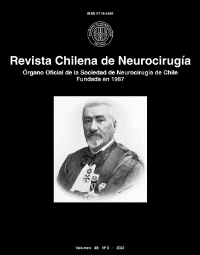Craniostenosis treated by endoscopic assistance: A case report
##plugins.themes.bootstrap3.article.main##
Abstract
Full-term newborn, female, with tanatophyric dysplasia type II, achondroplasia, hypertelorism, low ear implantation, multiple osteoarticular malformations, macrocephaly, craniostenosis and other anomalies. Upon evaluation by the neurosurgery team, the syndromic face and signs of Intracranial Hypertension were found, due to hydrocephalus, associated with bilateral temporal suture disjunction and craniostenosis of the sagittal suture. Surgery was performed for ICH compensation 10 days after birth. The patient evolved with normotensive anterior fontanel and improvement of the suture dysjunction. On the 45th day after the first surgery, the patient again presented progressive ICH signs. Anticipating surgery for correction of the sagittal craniostenosis. Performed with the aid of neuroendoscopy for bone resection of the fused suture. Craniostenosis is a rare condition characterized by premature fusion of cranial sutures. Its result is abnormalities of brain development, ICH, and decreased cognitive function. Patterns of genetic inheritance and mutations are identified as causing this pathology. The first and most common sign of craniostenosis is the abnormal shape of the skull. 3D Computed Tomography of the skull is the standard method for diagnosis. Open surgery is most common in syndromic craniostenosis. However, more conservative approaches should be considered pending surgery. Endoscopic surgical intervention is most appropriate until 6 months of age. The patient in the reported case has syndromic craniostenosis, and endoscopic treatment is not common. In surgical cases in which the disease was identified early, the prognosis tends to be positive.
##plugins.themes.bootstrap3.article.details##
Cranial suture, syndromic craniostenosis, sagittal craniostenosis, endoscopic management

This work is licensed under a Creative Commons Attribution-NonCommercial 4.0 International License.








